
SUSTAINABLE COMMERCE
SUSTAINABLE COMMERCE
We embrace sustainable practices to support a thriving environment.
40% of our GMV is from pre-owned and refurbished products.
We strive to empower our customers and promote a healthier planet.

eBay has always fostered a vibrant marketplace built on value and opportunity. Because of this, we have a responsibility to do business with the planet and our communities in mind. Sustainability has been part of our DNA for nearly three decades, starting with the very first sale of a broken laser pointer, a testament to the power of giving items a new life.
In our 2023 Impact Report, we're proud to share the progress we've made in our commitment to operating as a responsible business and creating a more sustainable future.
Sellers and buyers worldwide embrace eBay’s recommerce for its economic benefits and positive impact on the planet, with pre-owned and refurbished products now making up 40% of our GMV. In 2023, eBay created $4.9 billion in positive economic impact, while avoiding 1.6 million metric tons of carbon emissions and 69,000 metric tons of waste. Through recommerce, we're extending the life of products, diverting them from landfills, and empowering customers to make sustainable choices. We're also well on our way to achieving 100% renewable energy for our data centers and offices, and we're investing in clean energy initiatives around the globe.
We're eager to continue this journey, working tirelessly to make eBay a sustainable company that empowers our customers and promotes a healthier planet.
Environmental Footprint
We continuously seek to better understand, track, and quantify our environmental impact. Our Science-Based Target and annual Task Force on Climate-Related Financial Disclosures (TCFD) report shows our momentum toward climate transparency and action — as do our continued participation in the CDP climate survey and inclusion in the Dow Jones Sustainability World Index and Dow Jones Sustainability North America Index.
Learn more about our Science-Based Target and read our annual TCFD report, and Environmental Policy.
Greenhouse Gas Emissions
We report our GHG emissions in accordance with the World Resource Institute’s Greenhouse Gas Protocol. We set a Science-Based Target to reduce Scopes 1 and 2 emissions by 90% by 2030 from our 2019 baseline and achieve 20% absolute reduction in Scope 3 downstream transportation and distribution GHG emissions by 2030 from our 2019 baseline. Data coverage includes 100% of our operations. In 2023, we were carbon neutral for Scopes 1 and 2.
Emissions by Scope
When looking at our corporate footprint, data centers comprise 62% of our direct Scopes 1 and 2 emissions, while offices and direct business travel contribute to the remainder. As with most companies, our Scope 3 emissions far outweigh our Scopes 1 and 2. And as an online marketplace, the majority of our value chain emissions specifically come from the delivery of products.
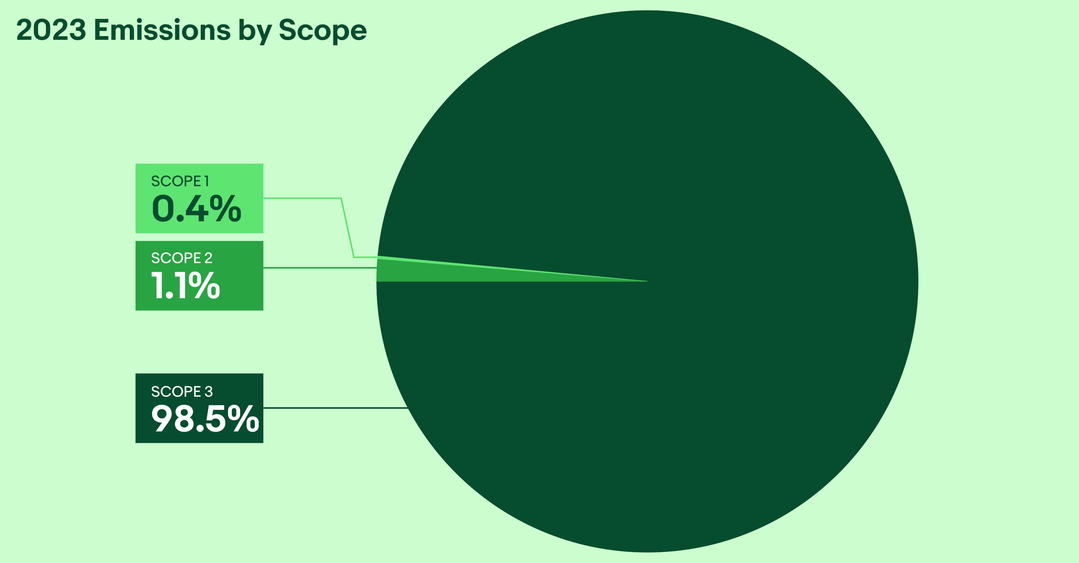
About this chart: Greenhouse Gas Emissions
Pie chart showing the breakdown of our greenhouse gas emissions, with Scope 1 making up 0.4%, Scope 2 making up 1.1% and Scope 3 making up 98.5% of our total emissions.
Scopes 1 and 2
In 2023, we continued to implement energy-efficient practices, including lighting upgrades at several U.S. and global locations. In our data centers, we continue to invest in more efficient cooling systems to reduce operational energy use. Overall, this has led to a 59% reduction in our Scope 1 and 2 emissions from our 2019 baseline. We’ve also purchased offsets to achieve carbon neutrality for the remainder of these emissions. Please see our voluntary carbon market disclosure act statement for AB1305 here.
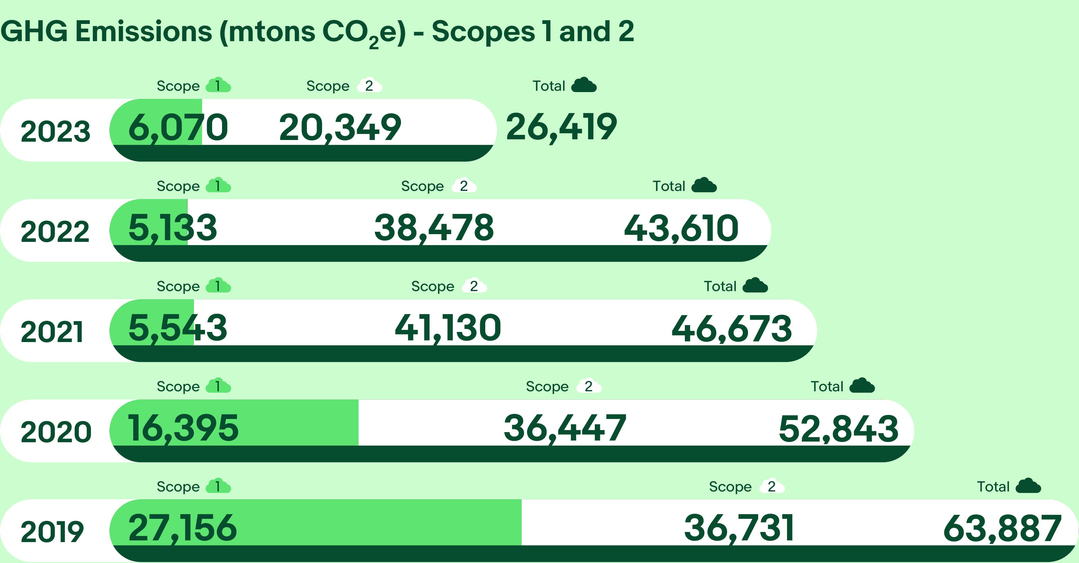
About this chart: Scopes 1 and 2 Emissions
Chart showing year-over-year changes in Scopes 1 and 2 emissions. In 2019, total Scopes 1 and 2 emissions equalled 63,887 mtons CO2e: 27,156 mtons CO2e came from Scope 1 emissions and 36,731 mtons CO2e came from Scope 2 emissions. In 2020, total Scopes 1 and 2 emissions decreased to 52,843 mtons CO2e: 16,395 mtons CO2e came from Scope 1 emissions and 36,447 mtons CO2e came from Scope 2 emissions. In 2021, total Scopes 1 and 2 emissions decreased to 46,673 mtons CO2e: 5,543 mtons CO2e came from Scope 1 emissions and 41,130 mtons CO2e came from Scope 2 emissions. In 2022, total Scopes 1 and 2 emissions decreased to 43,610 mtons CO2e: 5,133 mtons CO2e came from Scope 1 emissions and 38,478 mtons CO2e came from Scope 2 emissions. In 2023, total Scopes 1 and 2 emissions decreased to 26,419 mtons CO2e: 6,070 mtons CO2e came from Scope 1 emissions and 20,349 mtons CO2e came from Scope 2 emissions.
Scope 3
In 2023, our Scope 3 emissions were primarily derived from the shipping and transportation of items purchased online. In addition, purchased goods and services and use of sold products comprised other significant sources of Scope 3 emissions. For eBay, use of sold products refers to the use of our online marketplace on electronic devices.
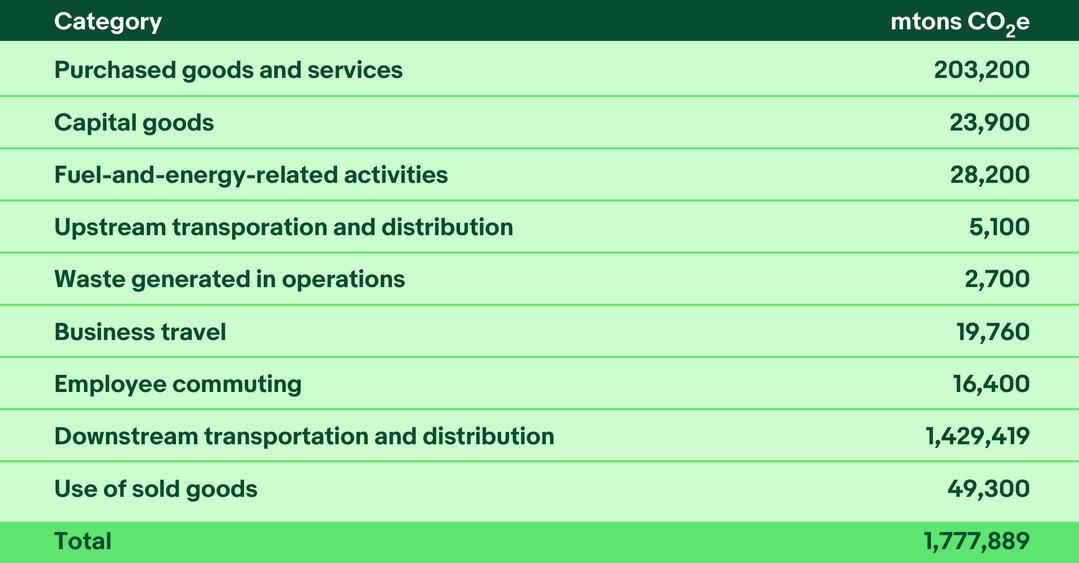
About this chart: Scope 3 GHG Emissions by Category
Chart showing category breakdown of our Scope 3 emissions. Contributions include 200,800 mtons CO2e from purchased goods and services, 23,100 mtons CO2e from capital goods, 28,200 mtons CO2e from fuel-and-energy-related activities, 5,100 mtons CO2e from upstream transportation and distribution, 2,700 mtons CO2e from waste generated in operations, 19,760 mtons CO2e from business travel, 16,400 mtons CO2e from employee commuting, 1,429,419 mtons CO2e from downstream transportation and distribution, and 49,300 mtons CO2e from the use of sold goods.
Scope 3 Shipping
In 2023, our Scope 3 emissions were primarily derived from the shipping and transportation of items purchased online. In addition, purchased goods and services and use of sold products comprised other significant sources of Scope 3 emissions. For eBay, use of sold products refers to the use of our online marketplace on electronic devices.
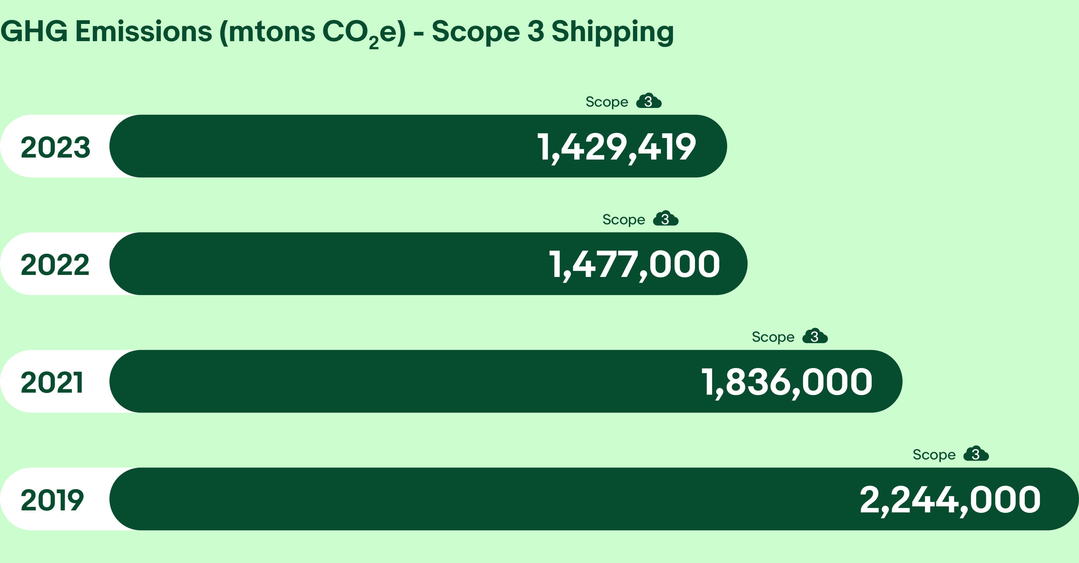
About this chart: Scope 3 Shipping
Chart showing year-over-year changes in Scope 3 Shipping emissions: 2,244,000 mtons CO2e in 2019, 1,836,000 mtons CO2e in 2021, 1,477,000 mtons CO2e in 2022, and 1,429,419 mtons CO2e in 2023.
Energy
Like other tech companies, our largest environmental impact comes from energy use in our offices and data centers, in addition to our authentication centers — which is why we’re committed to investing in clean energy sources, with a goal to use exclusively renewable energy.
Energy Use
We started a multi-year retrofit of our data centers in 2023, which comprised 88% of our energy use in the same year. Our Mission Critical Engineering Design & Construction team is creating a plan to make our operations more sustainable by using less energy and water. And with artificial intelligence (AI) demand on the rise and driving a number of key company initiatives, we’re monitoring potential AI impacts on energy usage, and assessing investment opportunities to mitigate expected increases in energy consumption.
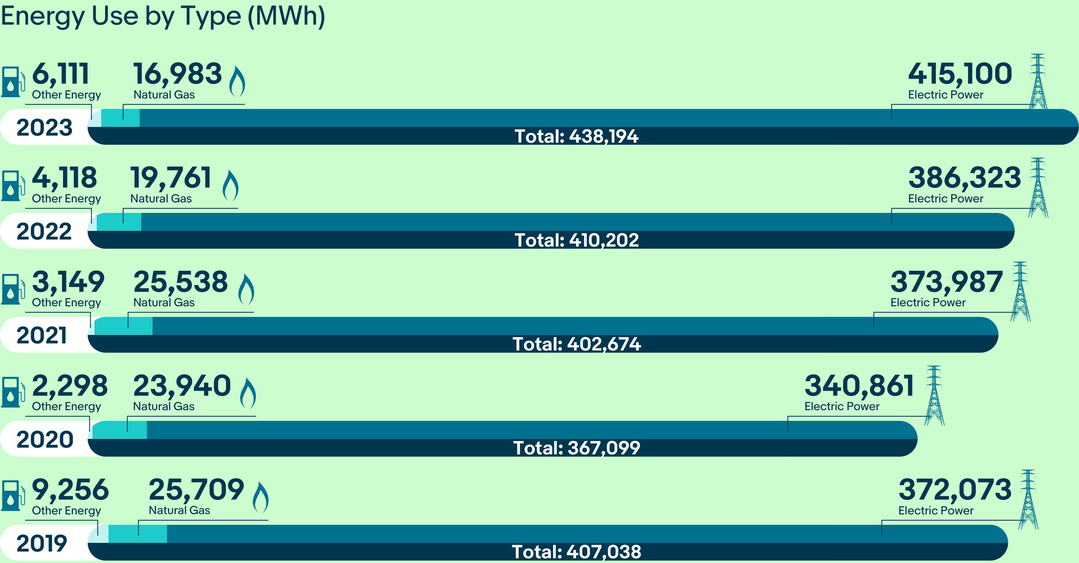
About this chart: Energy Use by Type
Chart showing the breakdown of energy use from 2019 to 2022 by energy type. In 2019, our offices, authentication centers and data centers used a total of 407,038 MWh of energy: 372,073 MWh of electric power, 25,709 MWh of natural gas and 9,256 MWh of other energy. In 2020, we used 367,099 MWh of total energy: 340,861 MWh of electric power, 23,940 MWh of natural gas and 2,298 MWh of other energy. In 2021, we used 402,674 MWh of total energy: 373,987 MWh of electric power, 25,538 MWh of natural gas and 3,149 MWh of other energy. In 2022, we used 410,202 MWh of total energy: 386,323 MWh of electric power, 19,761 MWh of natural gas and 4,118 MWh of other energy. In 2023, we used 438,194 MWh of total energy: 415,100 MWh of electric power, 16,983 MWh of natural gas and 6,111 MWh of other energy.
Renewable Energy
In our efforts to use 100% renewable energy by 2025, we consistently search for local, renewable energy solutions to power our offices, authentication centers, and data centers. eBay has also invested in projects, such as virtual purchase power agreements (VPPAs) in Texas and Louisiana, when local solutions are not available, and we use 100% renewable energy at our San Jose headquarters along with seven other offices.
Our renewable energy usage has maintained at 91% due to an increase in overall electricity usage along with the transition from unbundled RECs to our VPPA projects. To address much of the remainder, we have completed an assessment of renewable energy options at international offices and will prioritize local green programs as feasible.
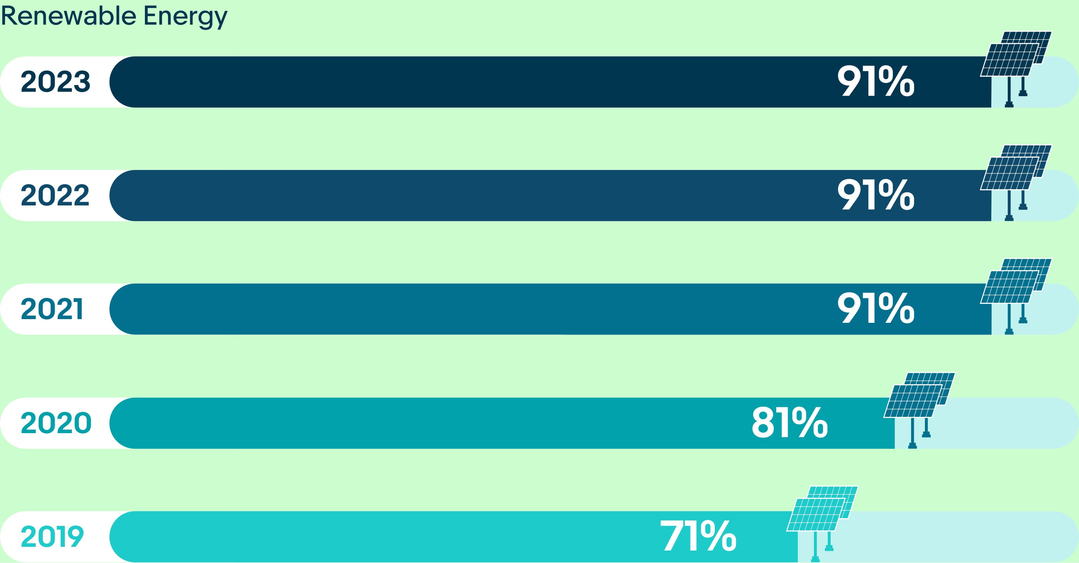
About this chart: Renewable Energy
Chart showing that from 2019 to 2022, our use of renewable energy has increased from 71% in 2019, to 81% in 2020, to 91% in 2021, 2022, and 2023.
EPA Green Power Partnership
Since 2020, we have been an official member of the U.S. Environmental Protection Agency’s (EPA) Green Power Partnership, which encourages organizations to reduce the environmental impacts of conventional electricity by using green power. In 2023, we were once again included in the partnership’s Top 30 Tech & Telecom list, which highlights top green power partners in tech.
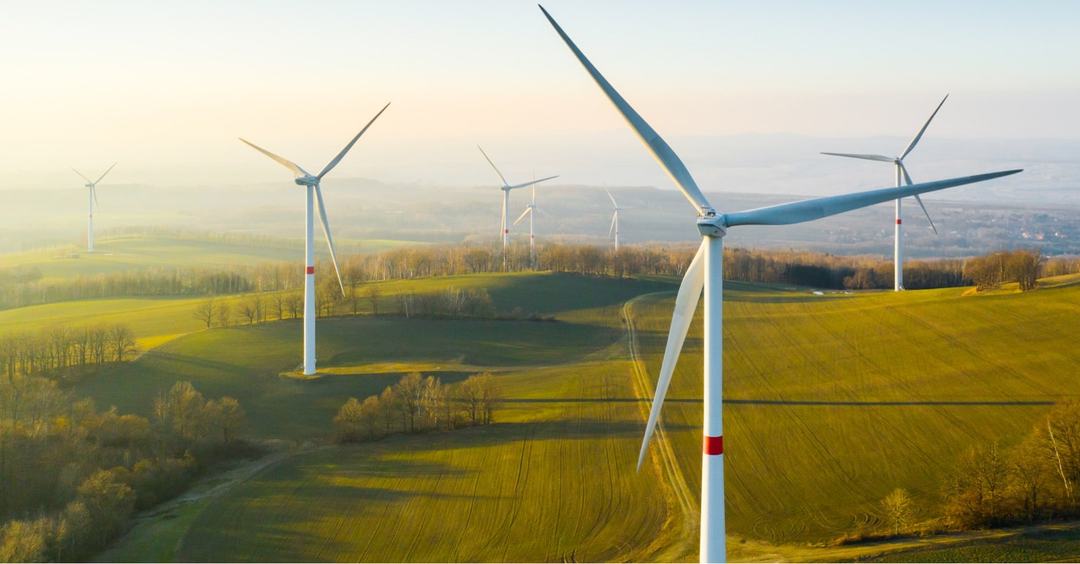
Shipping

In 2023, we made great strides in moving from measurement to decarbonization of our shipping-related emissions.
We implemented a three-pronged approach to decarbonization. The process includes policy advocacy, direct carrier engagement, and internal initiatives at eBay. We are catalyzing eBay’s resources, relationships, and leverage to engage carriers on joint decarbonization initiatives. For example, in 2023 we worked closely with the United States Postal Service to support adoption of their services that move packages from air travel to ground, greatly reducing the amount of packages that utilized aviation, and by extension our emissions.
We are engaging closely with our internal government relations team and outside industry associations to align on advancing policies on the international, national, and state level aimed at decarbonization of the transportation sector as a whole. Internally, we are assessing platform and operations levers we can use to reduce shipping emissions, such as prioritizing local delivery and promoting ground shipment over air to our buyers and sellers.
In addition to this three-pronged reduction strategy, we’re continuously improving our data collection and methodology to calculate emissions related to shipping and transportation to ensure we’re recording, reporting, and reducing our footprint. In 2022 and 2023, we surpassed our 20% reduction goal due to shifts in products sold and geographies of origin; however, the carbon intensity of shipping did not notably decrease. Through our three-pronged strategy we continue to be committed to decarbonize eBay’s shipping ecosystem to fully meet this goal by 2030.
Water and Waste
We’re continuing to make strides in water conservation and waste reduction across our global offices.
Water Consumption
Water consumption continues to be of utmost importance. We work to ensure our water use data collection is precise, and we annually perform a global water risk assessment. In 2023, we continued to convert to low-drip irrigation at our San Jose headquarters to reduce water usage. Our data centers use closed-loop, water-based cooling systems to decrease water loss as well.
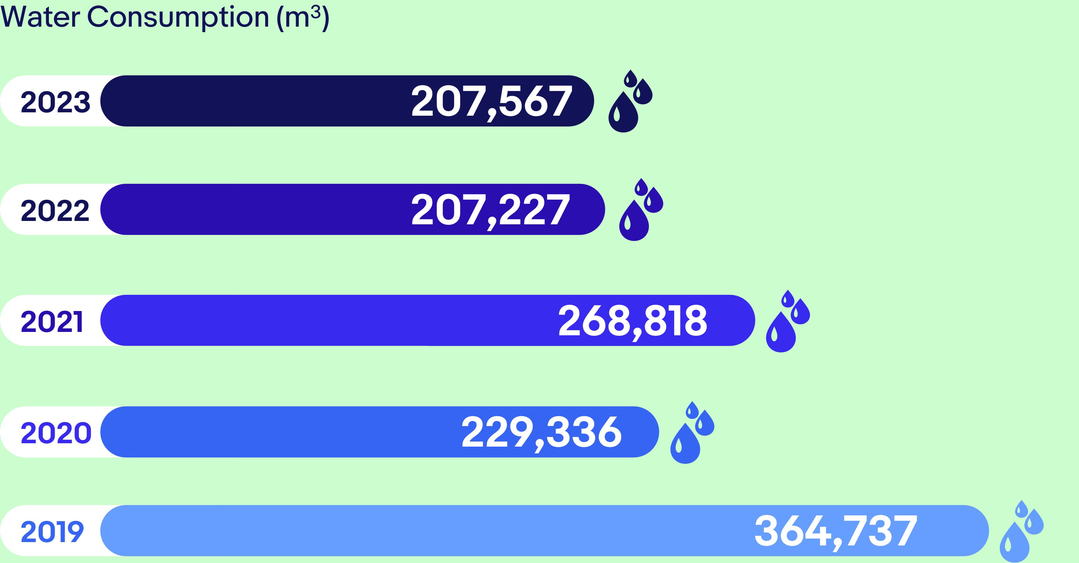
About this chart: Water Consumption
Chart showing changes in water consumption, from 364,737 m3 in 2019, to 229,336 m3 in 2020, to 268,818 m3 in 2021, to 207,227 m3 in 2022, to 207,567 m3 in 2023.
Waste Diversion
We remain committed to reducing the amount of waste that leaves eBay-owned sites. In 2023, we expanded recycling programs and initiatives, including implementing coffee grounds recycling in London and adding plastic recycling stations at our Switzerland office. We also introduced new biodegradable products at multiple facilities. At our San Jose headquarters, we have maintained a high waste diversion rate. In addition, we continue to refine our waste data collection process and increase reporting sites across global operations.
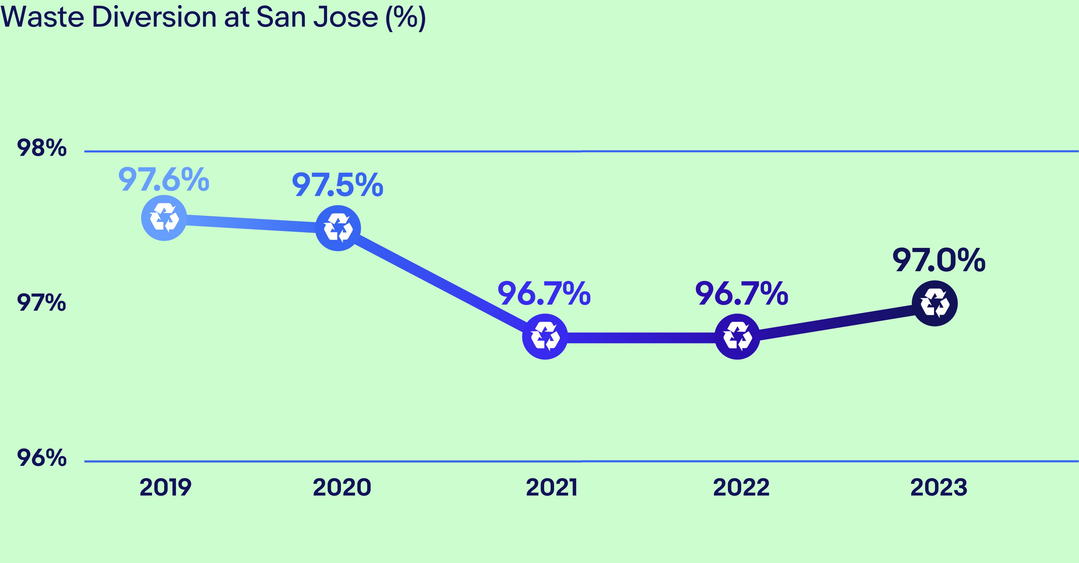
About this chart: Waste Diversion
Chart showing our waste diversion rate, which went from 96.7% in 2019, to 97.5% in 2020, to 96.9% in 2021, to 96.7% in 2022, to 97.0% in 2023.
Biodiversity
We continue to seek opportunities to protect biodiversity and limit our impact on local ecosystems.
Biodiversity Risk Assessment
In early 2024, we conducted a biodiversity risk assessment of our locations and examined their proximity to protected areas. This assessment evaluated potential risks throughout eBay’s portfolio of physical locations, including metro areas where eBay has a large presence. While none of our locations were deemed high risk, we continue to monitor each site closely for climate, biodiversity, or nature risks and impacts.

Key Sustainability Partnerships
We partner with several organizations to advocate for climate action and advance sustainable business practices, including:
eBay is a member of:
- Clean Energy Buyers Association (CEBA)
- Ceres Policy Network’s Business for Innovative Climate and Energy Policy (BICEP) coalition
- Utah Clean Energy Coalition
- Ellen Macarthur Foundation
- U.S. Environmental Protection Agency’s (EPA) Green Power Partnership
eBay Germany is finding innovative ways to reduce emissions, protect the environment, and boost the local economy. Here are just a few.
World Cleanup Day
Employees picked up trash on the eBay campus and a gardener from erdhummel (“earth bumblebee”) planted wildflowers that attract pollinators. At a seller recognition event, the German seller team planted 7,000 trees in Brandenburg.
Such measures are crucial to protect our nature and mitigate the effects of climate change. It's inspiring to see eBay taking responsibility and contributing to environmental protection.

eBay Lokal
eBay Germany recently launched eBay Lokal to help shoppers find products from local sellers, reducing transportation emissions and shipping costs.
Being able to purchase products nearby and supporting local dealers and communities is important. We want to strengthen neighborhood trade, break down barriers, and give products a second life through local exchange.

Recommerce
We pioneered recommerce, or circular commerce, with the first sale on our marketplace in 1995: a pre-owned laser pointer, purchased by someone who wanted to fix it and give it a second life.
Promoting a Healthy Cycle
We empower a thriving future.
The resale of pre-loved and refurbished goods on our global platform not only saves consumers money, but also conserves energy and resources, reduces greenhouse gasses, and keeps items out of landfills, bringing us closer to a more sustainable future.
From 2021 to 2025, we aim to avoid 8 million metric tons of carbon emissions and 350,000 metric tons of waste. We also plan to enable the creation of $22 billion in positive economic impact from money saved by purchasing pre-loved and refurbished goods on our marketplace. These goals have been adjusted from the initial ambition to account for our expanded boundaries in product categories and markets.
Our sellers and buyers around the world recognize recommerce as an important source of income and savings, with the added benefit of contributing to a healthier planet. In our latest Recommerce Report, we found that economic opportunity and sustainability remain key drivers behind the secondhand resale market.

eBay Refurbished
We support a circular economy through our eBay Refurbished program. This means extending product lifecycles and reducing the need for environmentally costly new manufacturing.
Our findings highlighted the avoided carbon emissions, avoided waste, and financial benefits associated with shopping refurbished. For example, in 2023, refurbished smartphone* sales on eBay in the U.S., U.K., and Germany avoided over 35,000 tons of GHG emissions, which is equal to taking 7,600 gas-powered cars off the road for a year. Read more about the impact of refurbished items in our 2023 Refurbished Report.
* This refurbishment process is for swapping out old batteries with a new, locally-sourced battery.


